Controlling Thermal Radiation in Photonic Quasicrystals Containing Epsilon-Negative Metamaterials
Abstract
:1. Introduction
2. Materials and Methods
2.1. Submission
2.2. Transfer Matrix Method
3. Numerical Results and Discussion
3.1. Temperature Dependance of the Semiconductor Permitivity
3.2. External Temperature
3.3. Incident Angle
3.4. Total Period Number
4. Conclusions
Author Contributions
Funding
Data Availability Statement
Conflicts of Interest
References
- Yablonovitch, E. Inhibited spontaneous emission in solid-state physics and electronics. Phys. Rev. Lett. 1987, 58, 2059. [Google Scholar] [CrossRef]
- John, S. Strong localization of photons in certain disordered dielectric superlattices. Phys. Rev. Lett. 1987, 58, 2486. [Google Scholar] [CrossRef]
- Tang, G.J.; He, X.T.; Shi, F.L.; Liu, J.W.; Chen, X.D.; Dong, J.W. Topological photonic crystals: Physics, designs, and applications. Laser Photon. Rev. 2022, 16, 2100300. [Google Scholar] [CrossRef]
- Christensen, T.; Po, H.C.; Joannopoulos, J.D.; Soljačić, M. Location and topology of the fundamental gap in photonic crystals. Phys. Rev. X 2022, 12, 021066. [Google Scholar]
- Han, W.; Qing, X.; Fangzhou, O. One-way two-dimensional photonic crystal absorber combined with graphene. J. Opt. 2023, 52, 339–346. [Google Scholar] [CrossRef]
- Chen, Z.; Shiomi, J.; Hu, R. Multi-band nonreciprocal thermal radiation via the coupling effect of tamm Plasmon and defect mode. SSRN Electron. J. 2023, 210, 4374467. [Google Scholar]
- Purcell, E.M. Spontaneous emission probabilities at radio frequencies. Phys. Rev. 1946, 69, 839. [Google Scholar]
- Maksimovic, Z.; Jaksic, M. Modification of thermal radiation by periodical structures containing negative refractive index metamaterials. Phys. Lett. A 2005, 342, 497–503. [Google Scholar] [CrossRef]
- Cornelius, C.M.; Dowling, J.P. Modification of planck blackbody radiation by photonic band-gap structures. Phys. Rev. A 1999, 59, 4736–4746. [Google Scholar] [CrossRef]
- Singhal, V.; Zhu, J.; Song, J.; Wang, H.; Bermel, P. Tri-phase photonic crystal emitter for thermophotovoltaic systems. Appl. Phys. Lett. 2023, 123, 131101. [Google Scholar] [CrossRef]
- Florescu, M.; Busch, K.; Dowling, J. Thermal radiation in photonic crystals. Phys. Rev. B 2007, 75, 20110. [Google Scholar] [CrossRef]
- Lee, B.J.; Fu, C.J.; Zhang, Z.M. Coherent thermal emission from one-dimensional photonic crystals. Appl. Phys. Lett. 2005, 87, 071904. [Google Scholar] [CrossRef]
- Sharma, Y.; Aman, A.; Prasad, S.; Singh, V. Properties of thermal radiation power spectra in truncated one-dimensional photonic crystals. Opt. Quantum Electron. 2017, 49, 341. [Google Scholar] [CrossRef]
- Costa, C.H.; Vascocselos, M.S.; Fulco, U.L.; Albuquerque, E.L. Thermal radiation in one-dimensional quasicrystals with graphene. Opt. Mater. 2017, 72, 756–764. [Google Scholar] [CrossRef]
- He, Y.; Guo, L.; Li, J.; Chen, Y.; Yin, C. Thermal emission of one-dimensional conjugated photonic crystals heterojunction embedded with graphene. Eur. Phys. J. B 2019, 92, 63. [Google Scholar] [CrossRef]
- Han, J.; Lakhtakia, A. Semiconductor split-ring resonators for thermally tunable terahertz metamaterials. J. Mod. Opt. 2008, 56, 554–557. [Google Scholar] [CrossRef]
- Zhu, Z.; Shi, C.; Liu, Y.; Zhang, D.; Wang, Q.; Du, Q.; Dong, X.; Li, S.; Wang, W. Enhanced performance of organic light-emitting diodes by integrating quasi-periodic micro-nano structures. Spectrochim. Acta A 2023, 292, 122401. [Google Scholar] [CrossRef]
- Oskouei, S.B.; Bayer, Ö. Experimental and numerical investigation of melting and solidification enhancement using Fibonacci-inspired fins in a latent thermal energy storage unit. Int. J. Heat Mass Transf. 2023, 210, 124180. [Google Scholar] [CrossRef]
- Ramakrishna, S.A. Physics of negative refractive index materials. Rep. Prog. Phys. 2005, 68, 449. [Google Scholar] [CrossRef]
- Shalaev, V.M. Optical negative-index metamaterials. Nat. Photonics 2007, 1, 41–48. [Google Scholar] [CrossRef]
- Wu, F.; Lu, G.; Guo, Z.; Jiang, H.; Xue, C.; Zheng, M.; Chen, C.; Du, G.; Chen, H. Redshift gaps in one-dimensional photonic crystals containing hyperbolic metamaterials. Phys. Rev. Appl. 2018, 10, 064022. [Google Scholar] [CrossRef]
- Xia, J.; Chen, Y.; Xiang, Y. Enhanced spin Hall effect due to the redshift gaps of photonic hypercrystals. Opt. Express 2021, 29, 12160–12168. [Google Scholar] [CrossRef]
- Wu, F.; Chen, M.; Xiao, S. Wide-angle polarization selectivity based on anomalous defect mode in photonic crystal containing hyperbolic metamaterials. Opt. Lett. 2022, 47, 2153–2156. [Google Scholar] [CrossRef]
- Padilla, W.J.; Dimitri, N.B.; Smith, D.R. Negative refractive index metamaterials. Materialstoday 2006, 9, 28–35. [Google Scholar] [CrossRef]
- Luan, P.-G. Metamaterials and transformation optics. In The Current Trends of Optics and Photonics; Springer: Dordrecht, The Netherlands, 2014; pp. 35–58. [Google Scholar]
- Baseri, A.; Keshavarz, A. Designing a double-negative metamaterial photonic crystal using the Thue-Morse sequence. J. Comput. Electron. 2022, 21, 270–279. [Google Scholar] [CrossRef]
- Baseri, A.; Keshavarz, A.; Hatef, A. A type of arrangement for photonic crystal structures interacting with a Terahertz wave with omnidirectional and thermal effects. J. Appl. Phys. 2020, 127, 214304. [Google Scholar] [CrossRef]
- King, P.D. Acoustic Properties of Periodically and Quasi-Periodically Modulated Waveguides. Master’s Thesis, University of Salford, Manchester, UK, 2006. [Google Scholar]
- Sukhoivanov, I.A.; Guryev, I.V. Photonic Crystals: Physics and Practical Modeling; Springer: Berlin/Heidelberg, Germany, 2009; Volume 152. [Google Scholar]
- Scott, C. The Spectral Domain Method in Electromagnetics; Norwood: Artech House, MA, USA, 1989. [Google Scholar]
- Hashemi, A.R.; Farzad, M.H.; Montakhab, A. Effect of Positional Disorder on Transmissional Properties of a Two-Dimensional Photonic Crystal: An FDTD Study. arXiv 2009, arXiv:0909.1022. [Google Scholar]
- Lucio, V.; Cicchetti, R.; Capece, P. Spectral dyadic Green’s function formulation for planar integrated structures. IEEE Trans. Antennas Propag. 1988, 36, 1057–1065. [Google Scholar]
- Li, Y.; Xiang, Y.; Wen, S.; Yong, J.; Fan, D. Tunable terahertz-mirror and multi-channel terahertz-filter based on one-dimensional photonic crystals containing semiconductors. J. Appl. Phys. 2011, 110, 073111. [Google Scholar] [CrossRef]
- Arvind, N.; Chen, G. Thermal radiation in 1D photonic crystals. In Radiative Transfer-IV. Fourth International Symposium on Radiative Transfer; Begel House Inc.: Danbury, CT, USA, 2004. [Google Scholar]
- Pigeat, P.; Rouxel, D.; Weber, B. Calculation of thermal emissivity for thin films by a direct method. Phys. Rev. B 1998, 57, 9293. [Google Scholar] [CrossRef]
- Iván, H.D.; Ruiz, A.C.; Raffi, L.M.G.; Romero-García, V. Matrix formulation in Acoustics: The transfer matrix method. Model. Sci. Educ. Learn. 2019, 12, 153–164. [Google Scholar]
- Rui, X.; Wang, X.; Zhou, Q.; Zhang, J. Transfer matrix method for multibody systems (Rui method) and its applications. Sci. China Technol. Sci. 2019, 62, 712–720. [Google Scholar] [CrossRef]
- Moharam, M.G.; Gaylord, T.K. Three-dimensional vector coupled-wave analysis of planar-grating diffraction. J. Opt. Soc. Am. 1983, 73, 1105–1112. [Google Scholar] [CrossRef]
- Sergey, S.; Shcherbakov, A.A. Reformulated Fourier Modal Method with improved near field computations. J. Comput. Sci. 2023, 67, 101936. [Google Scholar]
- Shen, H.; Wang, Z.; Wu, Y.; Yang, B. One-dimensional photonic crystals: Fabrication, responsiveness and emerging applications in 3D construction. RSC Adv. 2016, 6, 4505–4520. [Google Scholar] [CrossRef]
- Marie, D.; Jiménez-Solano, A.; Lotsch, B.V. Stimuli-responsive one-dimensional photonic crystals: Design, fabrication and sensing. Mater. Adv. 2022, 3, 7406–7424. [Google Scholar]
- Yang, M.K.; French, R.H.; Tokarsky, E.W. Optical properties of Teflon® AF amorphous fluoropolymers. J. Micro/Nanolithography MEMS MOEMS 2008, 7, 033010. [Google Scholar] [CrossRef]
- Krishna, M.; Ghanashyam, K.; Narasimha, R.; Mohan, S. Structural and optical properties of zirconia thin films. Thin Solid Films 1990, 193, 690–695. [Google Scholar] [CrossRef]
- Withayachumnankul, W.; Abbott, D. Metamaterials in the Terahertz Regime. IEEE Photonics J. 2009, 1, 99–118. [Google Scholar] [CrossRef]
- Mu, Q.; Fan, F.; Chen, S.; Xu, S.; Xiong, C.; Zhang, X.; Wang, X.; Chang, S. Tunable magneto-optical polarization device for terahertz waves based on InSb and its plasmonic structure. Photonics Res. 2019, 7, 325–331. [Google Scholar] [CrossRef]
- Yoshinaga, H.; Oetjen, R.A. Optical Properties of Indium Antimonide in the Region from 20 to 200 Microns. Phys. Rev. 1956, 101, 526. [Google Scholar] [CrossRef]
- Zhang, L.; Zhang, Y.; He, L.; Wang, Z.; Li, H.; Chen, H. Zero-bar n gaps of photonic crystals consisting of positive and negative index materials in microstrip transmission lines. J. Phys. D Appl. Phys. 2007, 40, 2579. [Google Scholar] [CrossRef]
- Howells, S.C.; Schlie, L.A. Transient terahertz reflection spectroscopy of undoped InSb from 0.1 to 1.1 THz. Appl. Phys, Lett. 1996, 69, 550–552. [Google Scholar] [CrossRef]
- Florescu, M.; Lee, H.; Stimpson, A.J.; Dowling, J. Thermal emission and absorption of radiation in finite inverted-opal photonic crystals. J Phys. Rev. A. 2005, 72, 033821. [Google Scholar] [CrossRef]
- Pendry, J.B.; Holden, A.J.; Robbins, D.J.; Stewart, W.J. Low frequency plasmons in thin-wire structures. J. Phys. Condens. Matter 1998, 10, 4785–4809. [Google Scholar] [CrossRef]
- Liang, Y.; Lin, H.; Lin, S.; Wu, J.; Li, W.; Meng, F.; Yang, Y.; Huang, X.; Jia, B.; Kivsha, Y. Hybrid anisotropic plasmonic metasurfaces with multiple resonances of focused light beams. Nano Lett. 2021, 21, 8917–8923. [Google Scholar] [CrossRef]
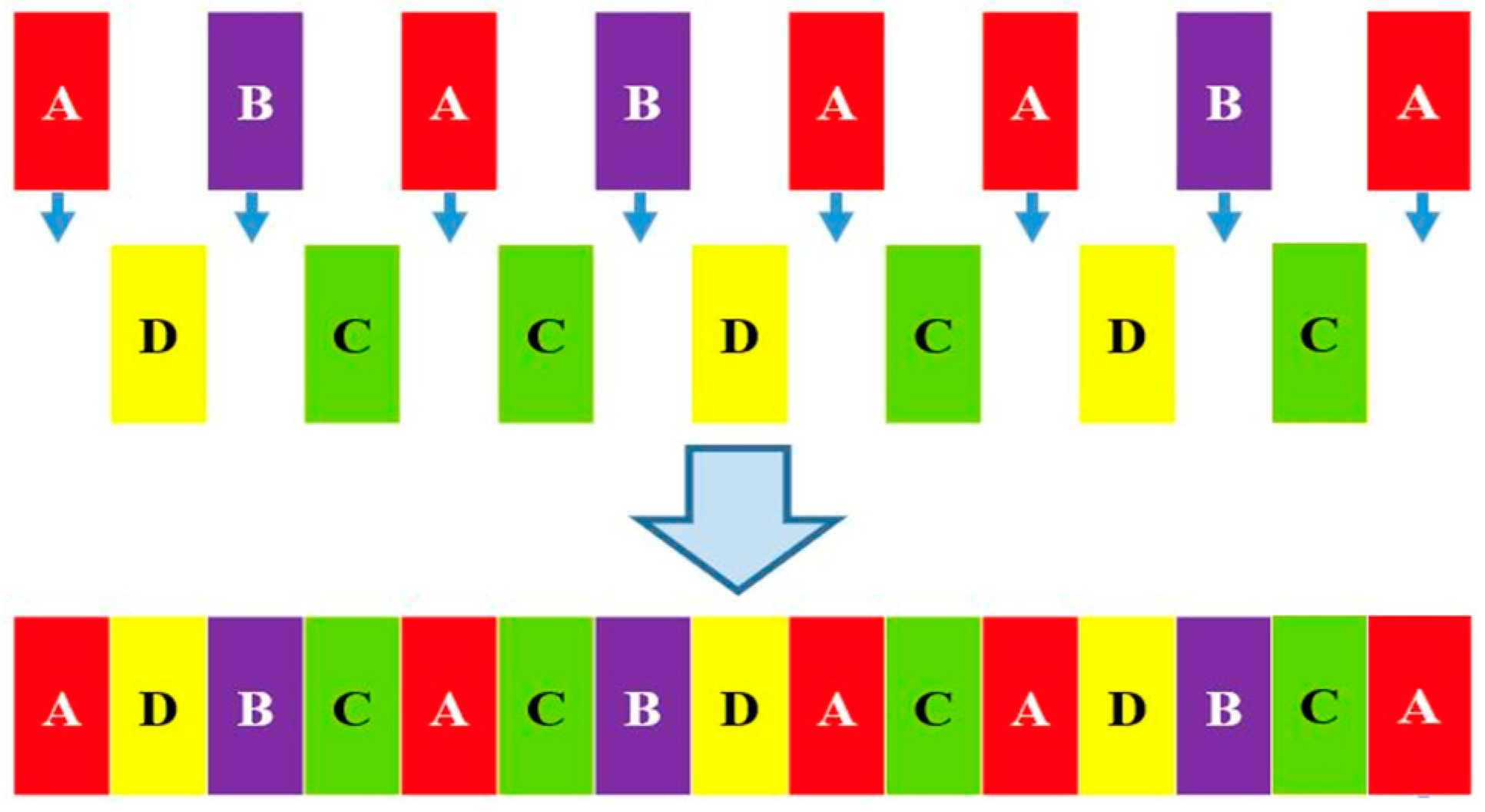
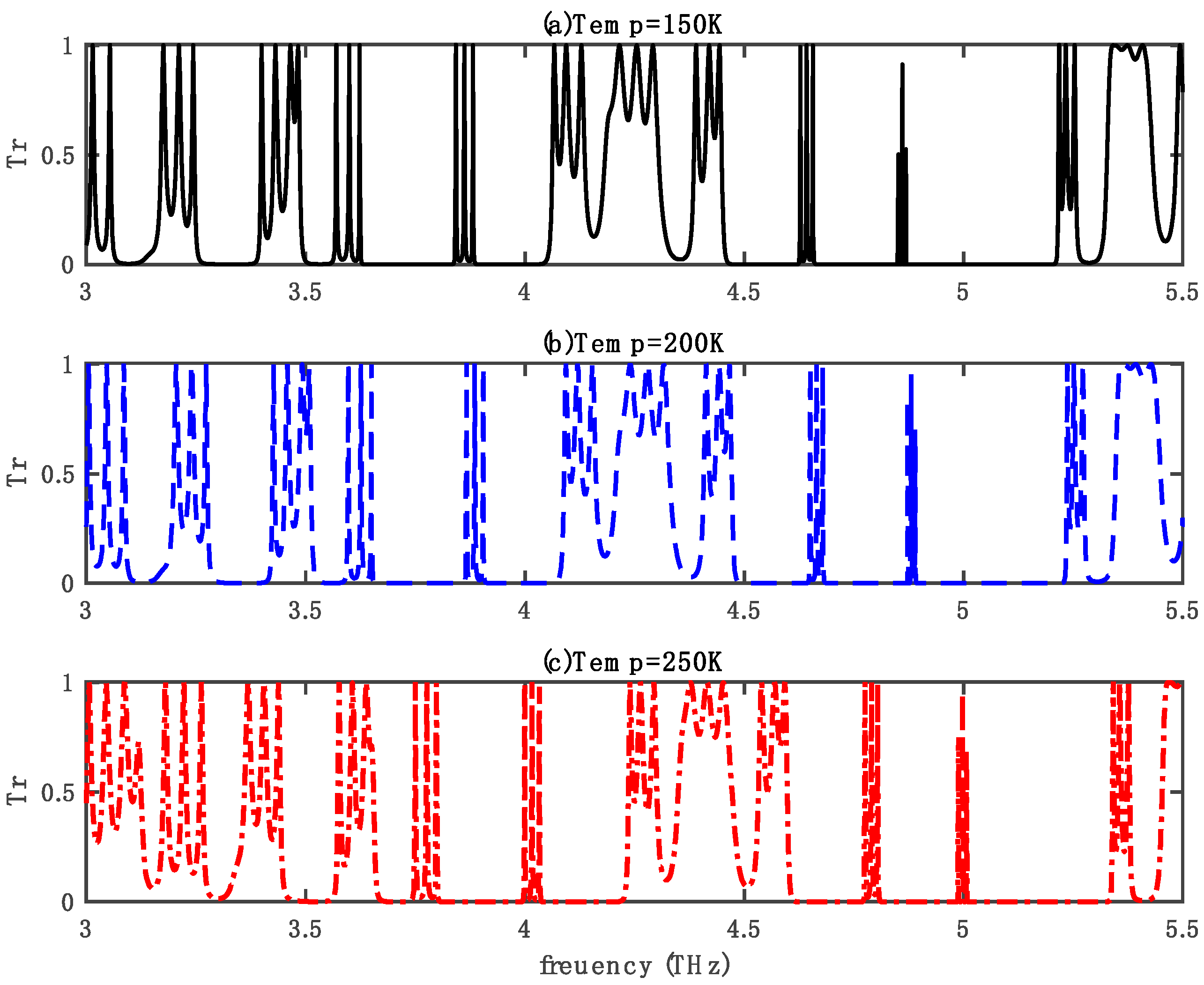
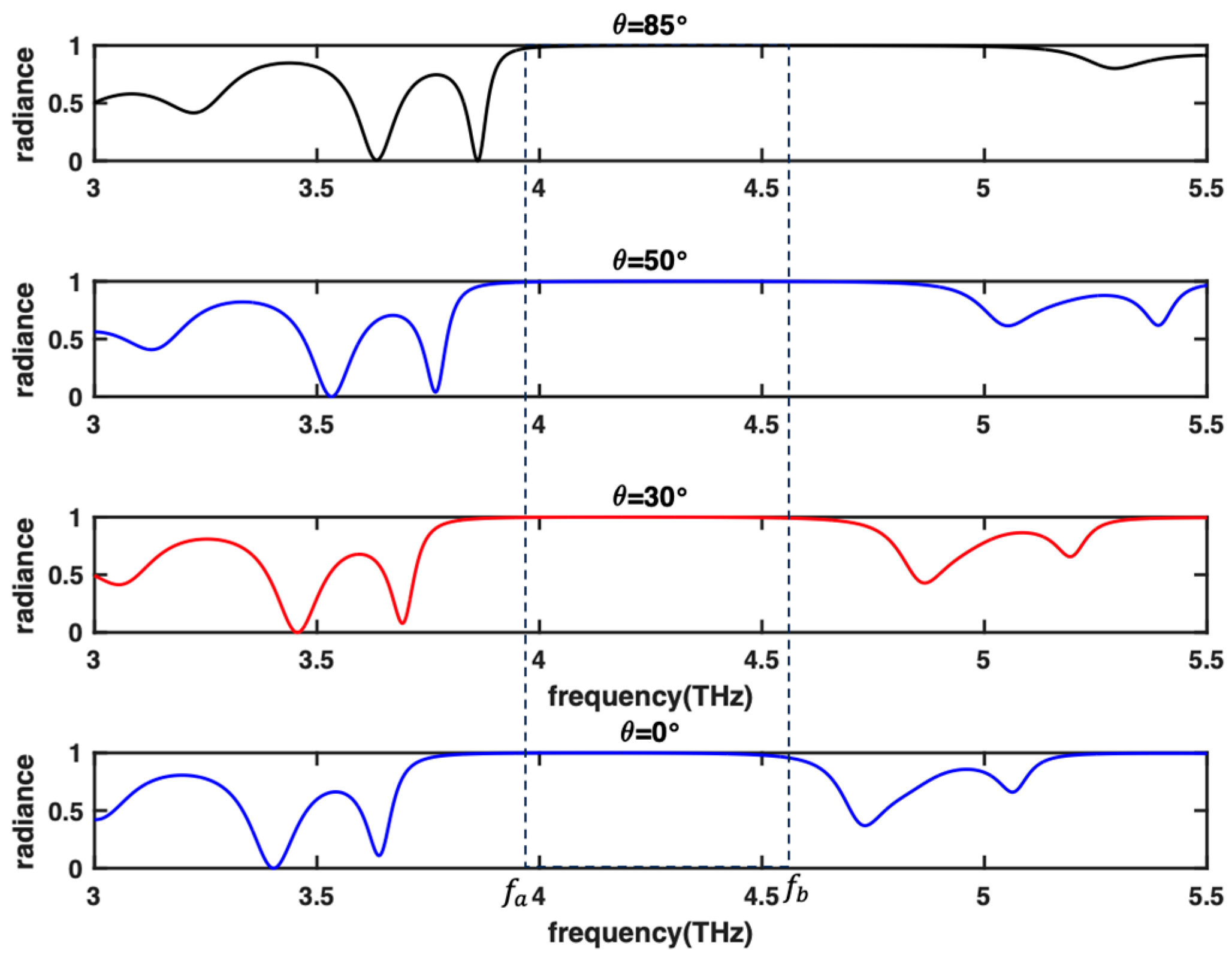
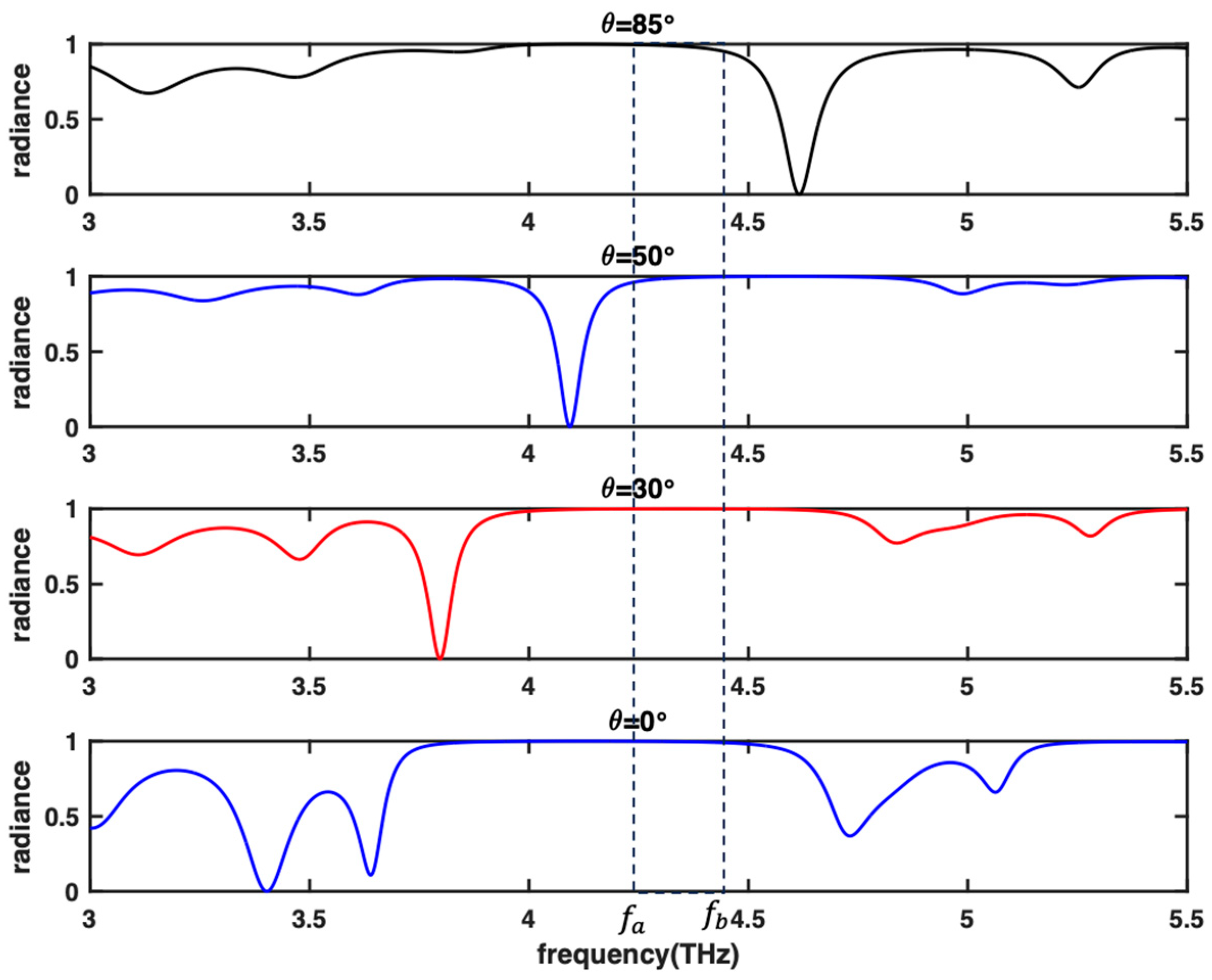
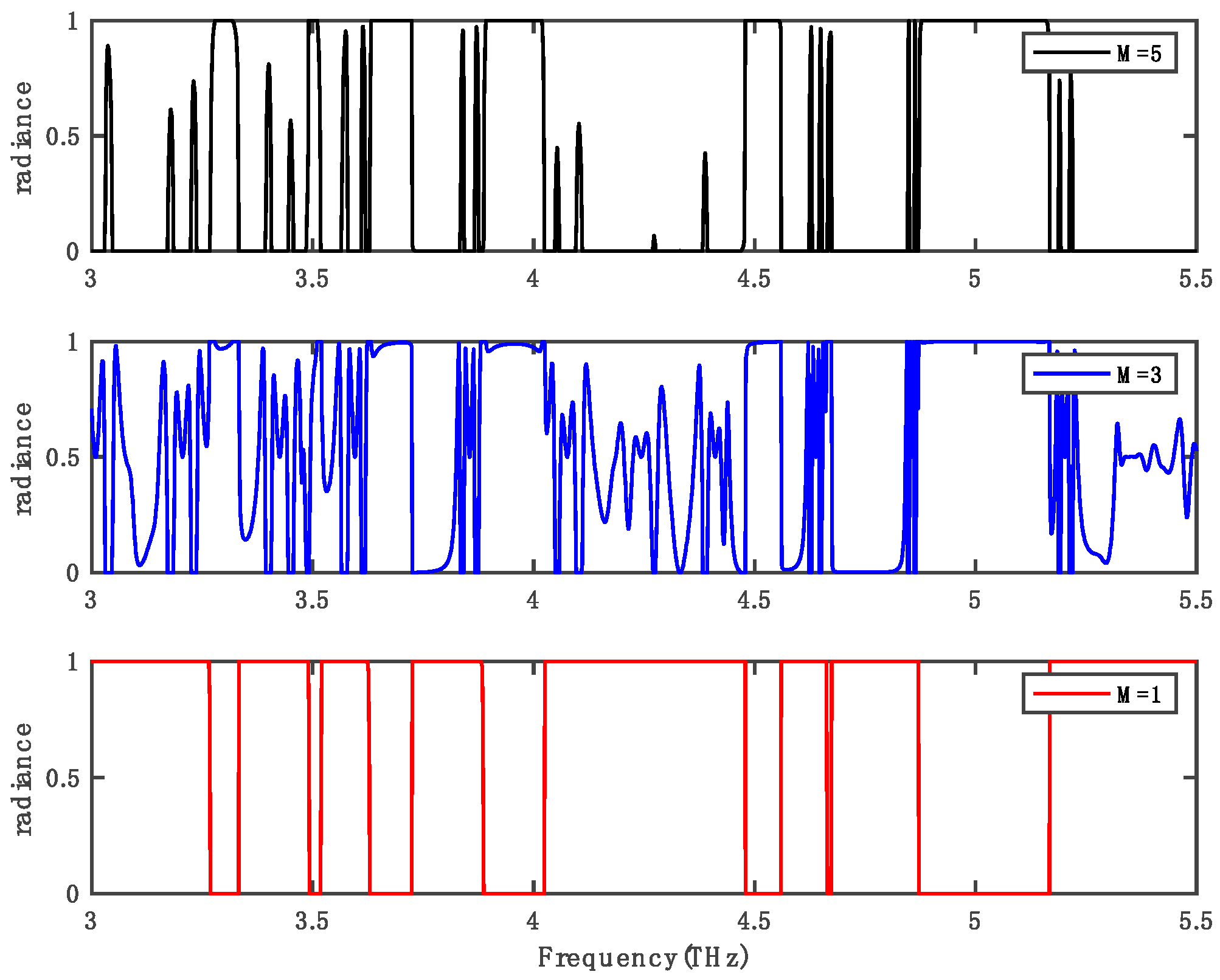
| Symbol | No. of Layer | Fibonacci Layer Sequence |
|---|---|---|
| S0 | 1 | B |
| S1 | 1 | A |
| S2 | 2 | BA |
| S3 | 3 | ABA |
| S4 | 5 | BAABA |
| S5 | 8 | ABABAABA |
| S6 | 13 | BAABAABABAABA |
| S7 | 21 | ABABAABABAABAABABAABA |
| Symbol | No. of Layer | Maximum Length Layer Sequence |
|---|---|---|
| S0 | 1 | D |
| S1 | 2 | DC |
| S2 | 4 | DCCD |
| S3 | 7 | DCCDCDC |
| S4 | 12 | DCCDCDCCDCCD |
| S5 | 19 | CCDCDCCDCCDCDCCDDC |
| S6 | 28 | CCDCDCCDCCDCDCCDDCCDCCDDCDC |
Disclaimer/Publisher’s Note: The statements, opinions and data contained in all publications are solely those of the individual author(s) and contributor(s) and not of MDPI and/or the editor(s). MDPI and/or the editor(s) disclaim responsibility for any injury to people or property resulting from any ideas, methods, instructions or products referred to in the content. |
© 2023 by the authors. Licensee MDPI, Basel, Switzerland. This article is an open access article distributed under the terms and conditions of the Creative Commons Attribution (CC BY) license (https://creativecommons.org/licenses/by/4.0/).
Share and Cite
Mikaeeli, A.; Keshavarz, A.; Baseri, A.; Pawlak, M. Controlling Thermal Radiation in Photonic Quasicrystals Containing Epsilon-Negative Metamaterials. Appl. Sci. 2023, 13, 12947. https://doi.org/10.3390/app132312947
Mikaeeli A, Keshavarz A, Baseri A, Pawlak M. Controlling Thermal Radiation in Photonic Quasicrystals Containing Epsilon-Negative Metamaterials. Applied Sciences. 2023; 13(23):12947. https://doi.org/10.3390/app132312947
Chicago/Turabian StyleMikaeeli, Ameneh, Alireza Keshavarz, Ali Baseri, and Michal Pawlak. 2023. "Controlling Thermal Radiation in Photonic Quasicrystals Containing Epsilon-Negative Metamaterials" Applied Sciences 13, no. 23: 12947. https://doi.org/10.3390/app132312947
APA StyleMikaeeli, A., Keshavarz, A., Baseri, A., & Pawlak, M. (2023). Controlling Thermal Radiation in Photonic Quasicrystals Containing Epsilon-Negative Metamaterials. Applied Sciences, 13(23), 12947. https://doi.org/10.3390/app132312947







